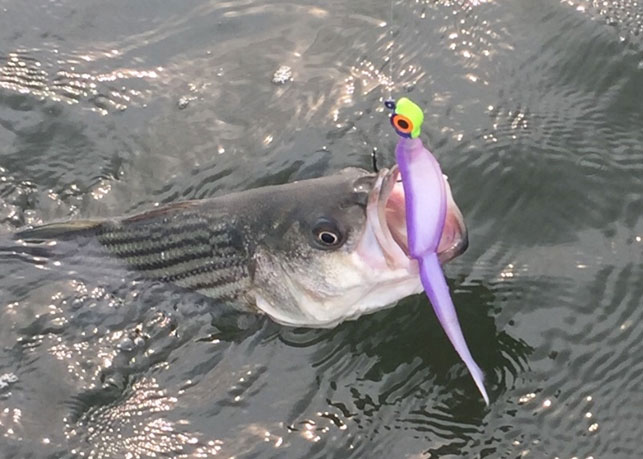If your jigging lures of choice are soft plastic paddletails or jerk baits, what size should you use during each season while fishing for striped bass? Listening to the AIC, FishTalk contributor Eric Packard, and G-Eye Jigs Captain LJ along with re-reading books by Battista, Kimbro, and others, I noticed a pattern. And I began to wonder if we could determine a very general and broad guideline for the size of soft plastics based on a simple calculation.

Yes! A scientifishic math pattern, checked against weekly FishTalk fishing reports and Chesapeake Bay and tributaries research captured in my notebook, emerged for most of the year. For a rule of worn-out, sanded thumb, starting from June and running through December, take the month’s number and divide by two — sometimes plus one.
For example, October is the tenth month, so that equals five inches. With the overused expression “size matters,” the goal is to match the size of the bait fish (match the hatch), and if you see bigger bait add that extra inch. Five- to six-inch paddletails should be the ticket for finicky rockfish. Note for November and December if the weather is colder than average add another inch — another inch of clothing, as well as another inch to the soft plastic. December now equals six to eight inches. Sound about right?
Other than April, when the rockfish season is closed, what about the other months in the year? The AIC said no more math (editor’s note: PLEASE!), so I checked out the historical January to March fishing reports and re-read the books again.
You need to go big from January to March, six to 10 inches. Finally, May is a transition month, so with the request for no math, May is month five, so simply stick with five-inch plastics.
|
Month |
Divide by 2 |
Range (Inches) |
Notes |
||
|
January |
1 |
N/A |
6 |
10 |
1 |
|
February |
2 |
N/A |
6 |
10 |
1 |
|
March |
3 |
N/A |
6 |
10 |
1 |
|
April |
4 |
CLOSED |
|||
|
May |
5 |
N/A |
5 |
6 |
2 |
|
June |
6 |
3 |
3 |
4 |
|
|
July |
7 |
3.5 |
3 |
4 |
3 |
|
August |
8 |
4 |
4 |
5 |
|
|
September |
9 |
4.5 |
4 |
5 |
3 |
|
October |
10 |
5 |
5 |
6 |
|
|
November |
11 |
5.5 |
5 |
6 |
3, 4 |
|
December |
12 |
6 |
6 |
7 |
4 |
Table Notes:
- Based on FishTalk’s fishing reports and articles along with books from Battista and Kimbro. Be sure to wear proper winter clothing and safety gear.
- Division by 2 not required!
- For the odd numbered months, July, September, and November round down.
- Increase the high end of range in November to seven inches and December to eight inches if weather is colder than average. Again, be sure to wear proper winter clothing and safety gear.
There you have it, all summarized in a handy table. Remember, this is just a general, broad guide to be used as a starting point of sorts, the key is to pay attention to the conditions, patterns, and size of the bait in your location. For June through December, the high end of the range in the table is generally applicable for light tacking trolling as well.
CAUTION: If you follow the tips, catch a ton of fish, and your thumb gets that sandpaper-like feeling, then certain applications on your cell phone that require a thumb print may not work… we are not responsible!
By Walt Tomczykowski
Editor’s note: Wait, if I can’t use my phone how the heck will I ever do the math!?